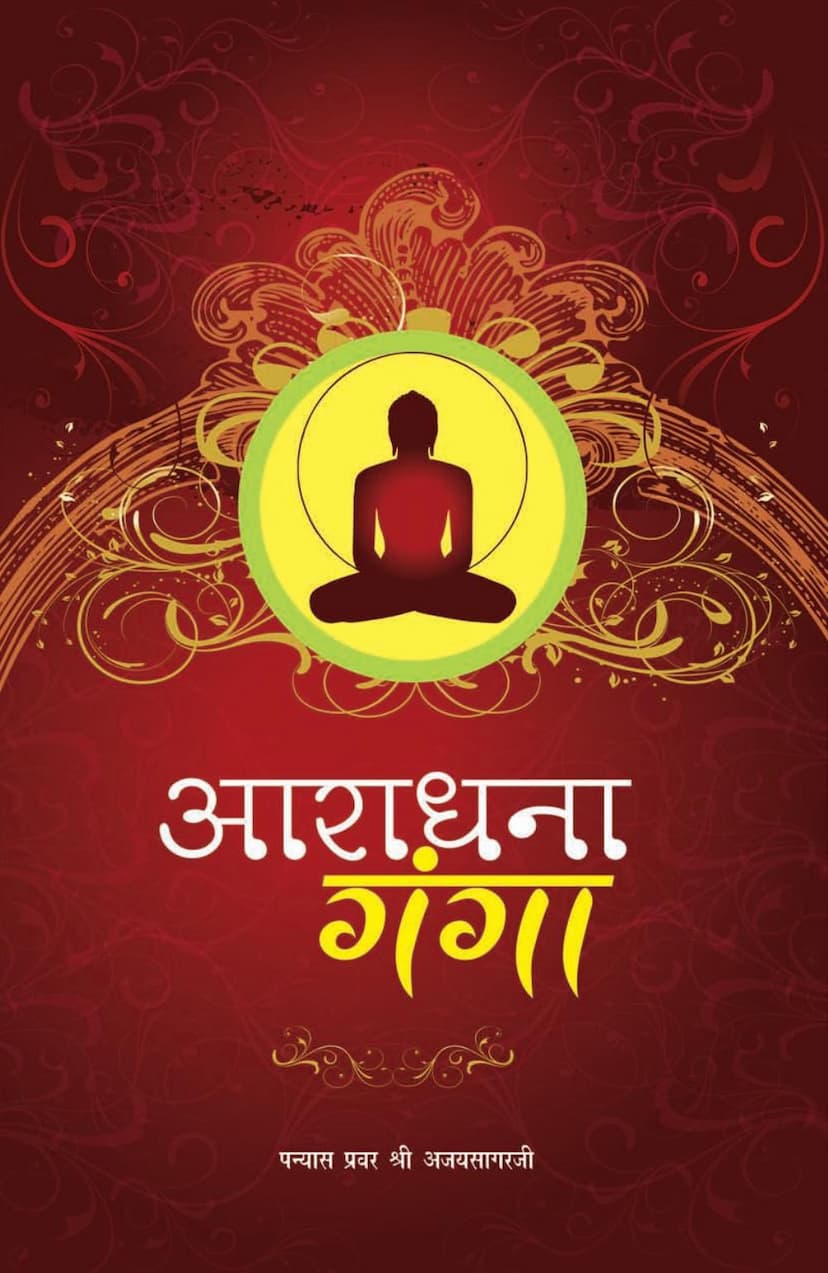Aradhana Ganga
Added to library: September 1, 2025

Summary
Here's a comprehensive summary of the Jain text "Aradhana Ganga" based on the provided pages:
Book Title: Aradhana Ganga (आराधना गंगा) Author: Panyas Pravar Shri Ajaysagarji (पंन्यास प्रवर श्री अजयसागरजी) Publisher: Sha Hukmichandji Medhaji Khimvesara Mandani, Chennai, Madurai (शा हुकमीचंदजी मेधाजी खींवेसरा मांडाणी, चेन्नई, मदुरै) Catalog Link: https://jainqq.org/explore/009725/1
Overall Theme:
"Aradhana Ganga" appears to be a collection of Jain devotional and ritualistic literature, likely compiled and edited by Panyas Pravar Shri Ajaysagarji under the guidance of Acharya Shri Padmasagar Surishwarji. The book focuses on various aspects of Jain worship, spiritual practices, and philosophical concepts, aiming to guide devotees in their spiritual journey.
Key Contents and Themes:
-
Devotional Services and Rituals:
- Twenty-Four Tirthankar Aradhana (२४ तीर्थंकर आराधना): The title explicitly mentions practices related to all 24 Tirthankaras, suggesting detailed descriptions of their worship, stanzas (stavan), hymns (stuti), and prayers (prabhu darshan ke samay bolne ki stutiyan).
- Temple Worship (जिन मंदिर विधि): The text provides detailed procedures for entering and worshipping in a Jain temple, including specific sequences for performing puja. This includes:
- Steps for entering the temple and offering respects.
- Purifications required for worship (जिन पूजा हेतु सात शुद्धियाँ).
- Circumambulations (pradakshina) around the deity with accompanying verses.
- Eight-fold worship (अष्टप्रकारी पूजा) and its components (water, sandalwood, flowers, incense, lamp, akshat, naivedya, fruit).
- Chaiyavandan (चैत्यवंदन) rituals, including specific postures (mudras) and mantras.
- The importance of specific verses and prayers during different stages of worship.
- Panchasutra (पंचसूत्र - सार्थ आदि): The text emphasizes the "Panchasutra" (five core Jain principles or mantras), particularly focusing on the first sutra, "Namaskar Mahamantra," and its profound meaning and application. Shri Ajaysagarji's new and insightful commentary on the first sutra is highlighted as a significant feature.
- Daily Practices (नित्य भावना): The book likely includes sections on daily spiritual practices and contemplations for sustained devotion.
-
Philosophical and Ethical Teachings:
- "Chitra Vichitra Jiv Sansar" (चित्र विचित्र जीव संसार): This section appears to be an extensive exploration of the Jain understanding of the universe and the cycle of births and deaths (samsara), detailing various life forms, their classifications, and their journeys through different life cycles. It categorizes beings based on:
- Indriyas (senses): Ekendriya, Dviindriya, Triindriya, Chaturindriya, Panchindriya.
- Kaya (bodies): Prithvikaya, Apkaya, Tejas Kaya, Vayukaya, Vanaspatikaya, Tras Kaya.
- Veda (sexes): Strīvedi, Purushvedi, Napunsakavedi.
- Gati (realms of existence): Naraka, Tiryancha, Manushya, Deva.
- Stages of spiritual development: Jiva, Siddha, Sansari, Jiva-rupa, Karma-bandha, etc.
- Detailed descriptions of hellish realms (Naraka) and celestial realms (Deva).
- "Pachchakkhan" (पच्चक्खाण - Vows and Restraints): The text includes guidelines and schedules for observing various vows and restraints, such as Upadhan Tapa, Ekasana, Biyasana, Ayambil, Tivihar, and Chaturmas Vrat. It details the rules and significance of these practices.
- "Nitya Bhavana" (नित्य भावना): This likely refers to ongoing spiritual contemplation and reflection.
- "Seven Types of Purification" (जिन पूजा हेतु सात शुद्धियाँ): This section emphasizes the importance of purity in body, clothing, mind, land, puja materials, wealth, and methodology for a successful spiritual practice.
- "Panchasutra" Commentary: The emphasis on the first sutra's commentary suggests a focus on understanding the fundamental principles of Jainism, particularly regarding overcoming negative karmas and cultivating positive qualities.
- "Chitra Vichitra Jiv Sansar" (चित्र विचित्र जीव संसार): This section appears to be an extensive exploration of the Jain understanding of the universe and the cycle of births and deaths (samsara), detailing various life forms, their classifications, and their journeys through different life cycles. It categorizes beings based on:
-
Social and Community Initiatives:
- "Gyanbhandar Udhar" (ज्ञानभंडार उद्धार): The text highlights a significant community effort in Chennai to revive and organize the Shri Vijayhirasurishwarji Gyanbhandar (knowledge repository). This involved the dedication of youth, the establishment of reading rooms, and the creation of a website to catalog Jain literature, making it accessible globally.
- Website Development: A multi-purpose website was launched to list the contents of the Gyanbhandar, with the vision of enabling any Jain knowledge repository worldwide to upload its catalog. This aims to connect scholars and seekers with Jain resources.
- Promoting Tapasya: The text mentions a strong atmosphere of asceticism within the family and community, with several individuals undertaking severe austerities (like Masakshaman) and smaller penances, bringing merit and blessings.
-
Personal Reflections and Gratitude:
- The preface likely includes expressions of gratitude from the publishers (Hukmichandji Medhaji Khimvesara family) to Acharya Shri Padmasagar Surishwarji for permission to stay in the south for Chaturmas and to Shri Ajaysagarji for his editorial work.
- There's a personal sentiment expressed about fulfilling a long-held desire of the publishers' parents for a Chaturmas in Chennai, which coincided with Acharya Shri Padmasagar Surishwarji's spiritual presence.
- Shri Ajaysagarji shares his personal experience and deep connection with the Panchasutra, having contemplated its verses numerous times, and expresses his intention to provide a new, spiritually enriched commentary.
-
The Role of Ascetics:
- The book is dedicated to prominent Jain ascetics, including Acharya Shri Buddhisagar Surishwarji and Acharya Shri Kailassagar Surishwarji, and honors Panyas Pravar Shri Ajaysagarji. The continuous guidance and inspiration from these spiritual leaders are emphasized as crucial for the book's creation and the community's spiritual growth.
Structure and Purpose:
The book aims to be a comprehensive guide for Jain followers, providing:
- Practical instructions for daily worship and temple rituals.
- Deeper understanding of Jain philosophy, particularly the concept of karma and the soul's journey.
- Inspiration for observing austerities and vows.
- Information about key Jain scriptures and their significance.
- Encouragement for community participation in religious and knowledge-sharing activities.
In essence, "Aradhana Ganga" serves as a spiritual reservoir, offering a flow of devotional practices, profound philosophical insights, and a roadmap for adherents to cultivate righteousness and achieve liberation (moksha).